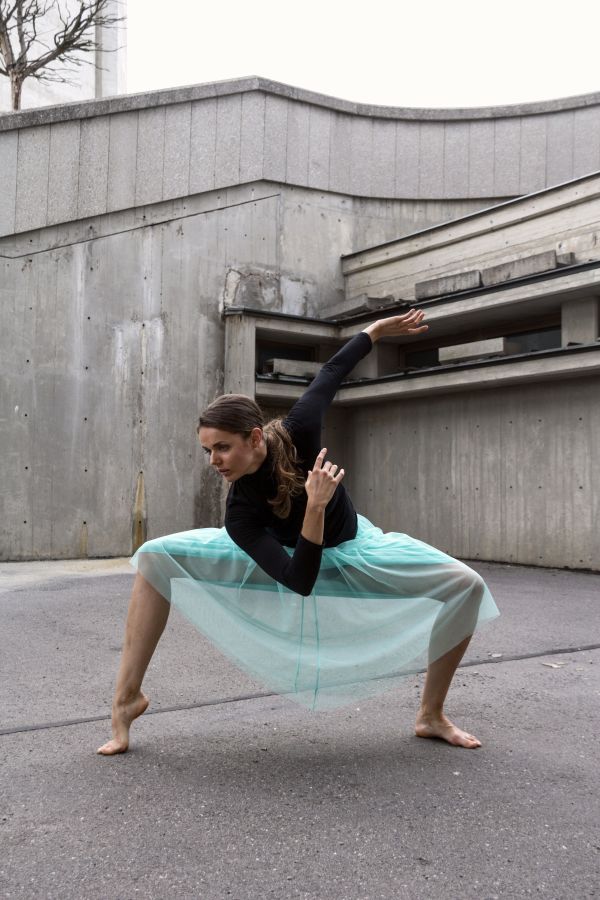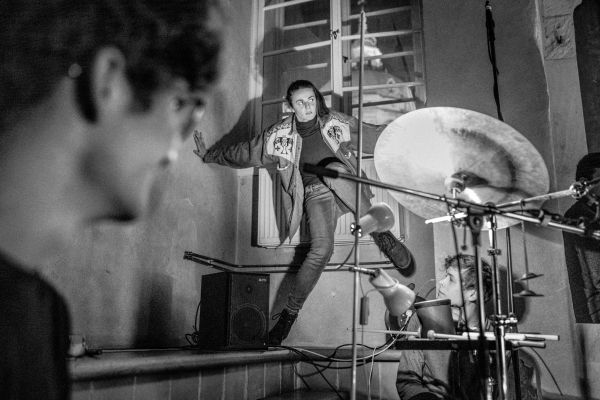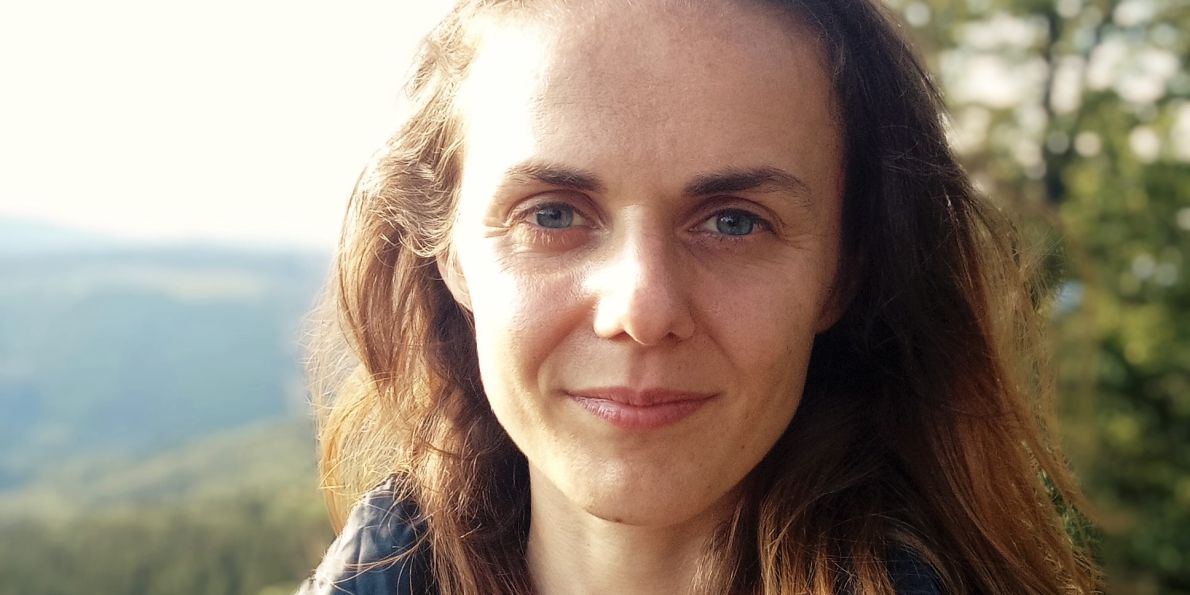When is a gesture a better means expression than a word? What can breathing do? How can it help us if we learn how to work with breath properly? Such are some of the issues that Natálie Podešvová, a performer, dancer, and choreographer faces. She is a student of Nonverbal Theatre at HAMU and performs with Dočasná Company – a troupe that unites artists across diverse genres. She focuses primarily on physical theatre and contemporary dance.
In addition to her studies at HAMU, she is also a graduated teacher for the first stage of primary schools, but she did not find working at school fulfilling. “As a first stage teacher, you need to switch between activities all the time to keep the children interested. But I like doing things intensively; I love being able to dive deep and explore. I enjoy teaching, but I feel like I make more sense when I teach motion and working with your body. I have more experience in it and, I think, I understand it better,” explains Natálie Podešvová.
She was a competition dancer for the Stonožka (Centipede) dancing school in Bruntál for eight years, including jazz and modern dance and hip hop. “That taught me the technique as well as how to work with a team and behave within one. It was great schooling, also because our coach was very tough.”
After that, she did not want to compete dancing but wanted more motion education. “I would go to various workshops, including abroad. Then I found you could study Nonverbal Theatre at HAMU, and it proved to be an excellent choice to me. Before that, I also applied for Drama Theatre at DAMU, but I realised that words are not the most genuine, innate means of expression for me.”
Does expressing yourself with your body, motion, and gestures work better for you than using words?
I sometimes find it easier to express emotion and thoughts using facial expressions, gestures… just physically, rather than having to search for words. That said, words are still important for the work I do. I get to realise increasingly more how important it is to name the emotions we experience in certain situations. When we name them, something abstract that happens inside someone can crystallise into something specific. Once it is specific, it is easier for the person to navigate.
Do you take this as a confirmation that nonverbal expressions are sometimes better at conveying messages? That others can understand them better, while words can be misleading?
It certainly is like that sometimes, including in a performance. But, of course, it doesn’t work like that at all times. That’s what rehearsals are good for. If you rehearse a performance all alone, it is good to have someone as an extra pair of eyes. In your head, everything may be working 100% perfectly, but when you are creating a situation physically in space as a performer, the receiving end does not have to understand it in the same way at all. Everyone has different experience, a different worldview, and so it is useful to share your plan or idea with someone before you bring it on stage. Ask and discuss, because, in certain cases, what you are trying to express are ideas so complex that you have a hard time finding the right form. It is especially in cases such as this that you need external help.
You said you wanted more motion education. What in particular are you interested in?
I am interested in the influence of what we do, our experience as motion actors, on personality; the way it forms and cultivates it. I feel that, by working with the body, voice, and acting experience, I get deeper into my core, making my human qualities more apparent – both the good and the bad ones. Motion practice and working with a team is what teaches me the soft skills that make it easier for me to communicate and generally function in real life. That’s why it makes a lot of sense to me.

Is this a part of personal development to you?
It might suggest therapy to someone, but that’s not what I want to do; I don’t really feel competent enough. I would prefer sharing or teaching the tools for getting close to oneself – for getting to know one’s body, its possibilities and, through that, the kind of person one is.
What are the tools for working with the body?
As far as creation is concerned, I draw a lot on the exercises we use in practicing physical theatre and contemporary dance. Those are motion principles that don’t necessarily have to be codified, but they let you develop them further and explore the levels of using them. There are many motion systems that us ‘motion artists’ use as sources. You can draw inspiration from martial arts, various dancing techniques, compensatory exercises, sports disciplines, and even common gestures. I can sometimes draw inspiration even from a motion defect that I notice in a passer-by. Out of that, you can create various motion patterns, with which we can play and discover options not only for motion but also for situations that emerge from them or that we get into through them.
I draw a lot of inspiration from Laban movement analysis, which explores the body relative to space, shape, and time and analyses various qualities of movement. I see it as a comprehensive system that is also clear enough to let a person understand themselves and know how to work with their body. In addition, I take interest in somatic approaches such as body-mind centring, as I like to perceive the relationships between the various body systems, movement, and the mental and psychic plane of the personality. In fact, I have perceived how movement is related to our state of emotion, how I can influence my mind and emotion with movement, since my adolescence when I was going through some psychically difficult periods.
What advice would you give me in a situation where I open my eyes in the morning feeling a bit under the weather, a bit down… What can I do to get up with a lighter mind and a better mood?
First, let it all fade away while in bed and stretch out. That way, you will activate blood and lymph circulation, perfusing and warming up your muscles. You can even voice a sound of relief out your mouth. Don’t be afraid to find what exactly your body needs. At home, you can do anything you can’t do in public. Then plant your feet firmly on the ground, get up, and take a deep breath. Calm down.
It is really important to just be for a moment, realise how you feel in your body, and give it what it needs. Don’t ask for everything at once. Then, do some exercise, even briefly. People’s tastes are different; some do yoga, some do the Five Tibetans, some go running, and some meditate sitting down in the morning. Everyone has their own morning ritual. It is good to find it and adhere to it. Then there are days when things don’t work. That’s fine, and there’s no point reproaching oneself for that. Anyway, I think this sort of ‘bed ritual’ is a good way to start your day.
Have you got your own breathing routine?
To me, it is important to play, and it doesn’t matter if I play with movement or with breath. I like playing with breath, its duration; I enjoy creating a rhythm and realising it. If I go running, I don’t listen to music – I adjust my tempo to my breath. When teaching, I often breathe quite loudly to show others how to work with breath when moving.

Let’s stick to breath. Many people will say, what’s the big deal? It’s natural. Why make such science out of breathing?
Even though breathing is a subconscious activity, happening without us having to think about it, our body comes alive with each breath taken and relaxes with exhaling. Oxygen transformation results in regenerating the body, and this is why breath is healing. It is a very strong mover. If you cannot work with breath and get into a stressful situation that gets you down, your adrenaline level will rise and you won’t know how to calm down. You don’t know what to do and need an external impulse – a person to tell us to stop. When, in turn, we can realise the situation and our mental state, we can do something on our own to become ‘at ease’ again soon: hold our breath for a moment, and then let out a long breath – we will find everything within and around us calming down.
You have covered the topic of self-mutilation in Effugio, your site-specific student project. As far as I can observe these days, this is a huge issue. What did you learn about the topic working on the project?
Initially, I would collect material on the topic, doing this ‘research’ as part of the show. I believe that everyone in our field does it this way – we don’t just ‘shoot from the hip’. I spoke to people who have experienced this, to a psychiatrist from the children’s ward in the Bohnice sanatorium, and to safety helpline workers. That was the core that I wanted to convey to dancers and performers. Something that I didn’t just make up; something that’s not just a singular case, but common situations. What we do is close our eyes to them and try to sweep them under the rug as taboo topics that we don’t want to talk about because that’s uncomfortable. But the problem only grows with silence. This is exactly what I was trying to convey with the show. We need to acknowledge that unpleasant things are part of life as well and learn to speak about the topic openly and without prejudice or downplaying.
What do you want to do once you graduate from HAMU?
I’m sure I want to work with people. I want to do motion theatre. I am attracted to non-theatrical venues. I want to play outdoors, in public space, performing and dancing even for passers-by who may not be eagerly interested in art. This type of projects is close to my heart.
Why?
Greater freedom of expression, I guess. I like contact with people. I enjoy contact with viewers, which is different outdoors from what they experience sitting down in a dark auditorium. That’s not to say I don’t like the black box, not at all. It’s all beautiful experience. Theatre is about the moment of sharing, and that’s most important to me. That’s where the meaning of theatre is for me: sharing an idea that transcends us, you, me as a person and an artist.
